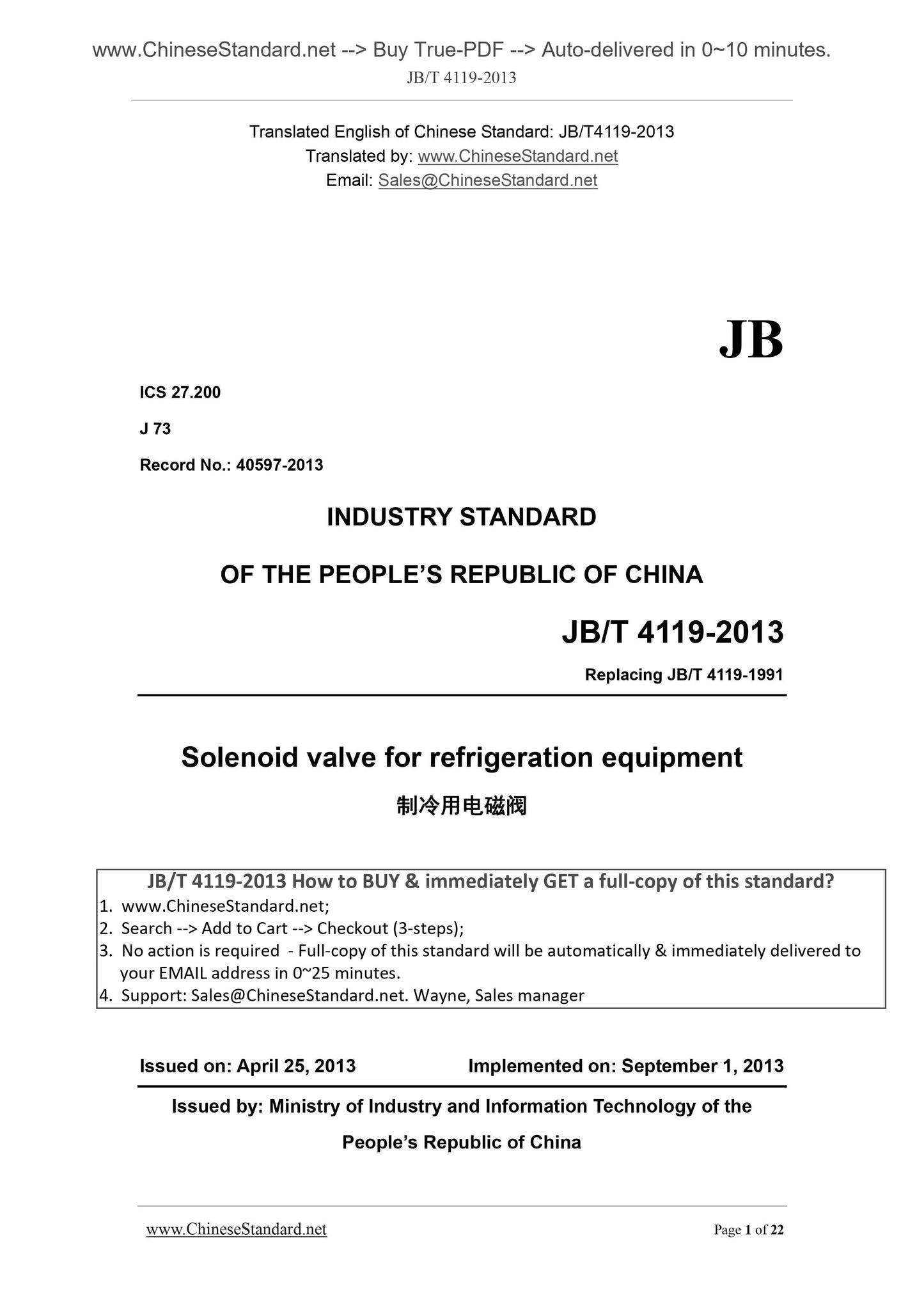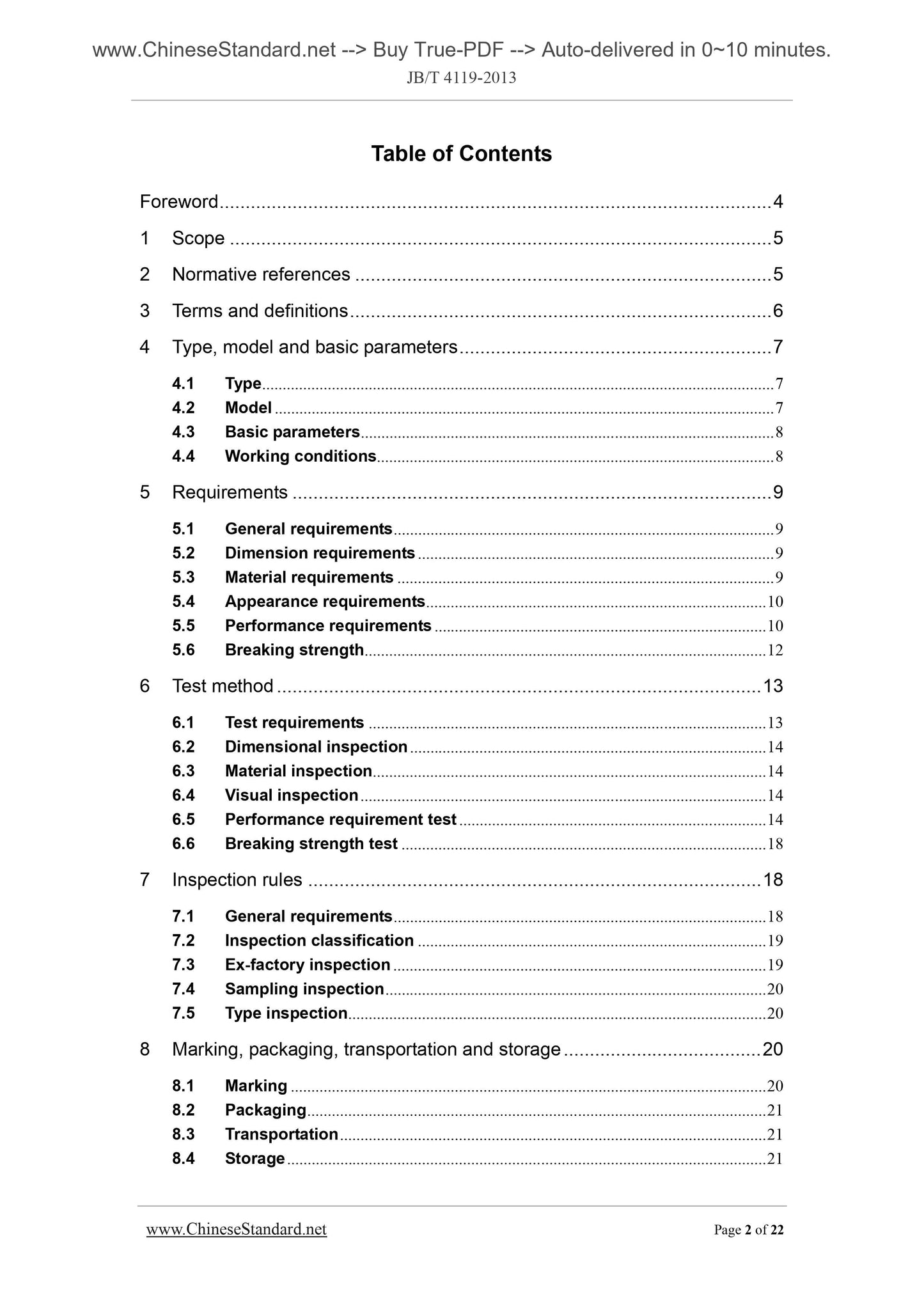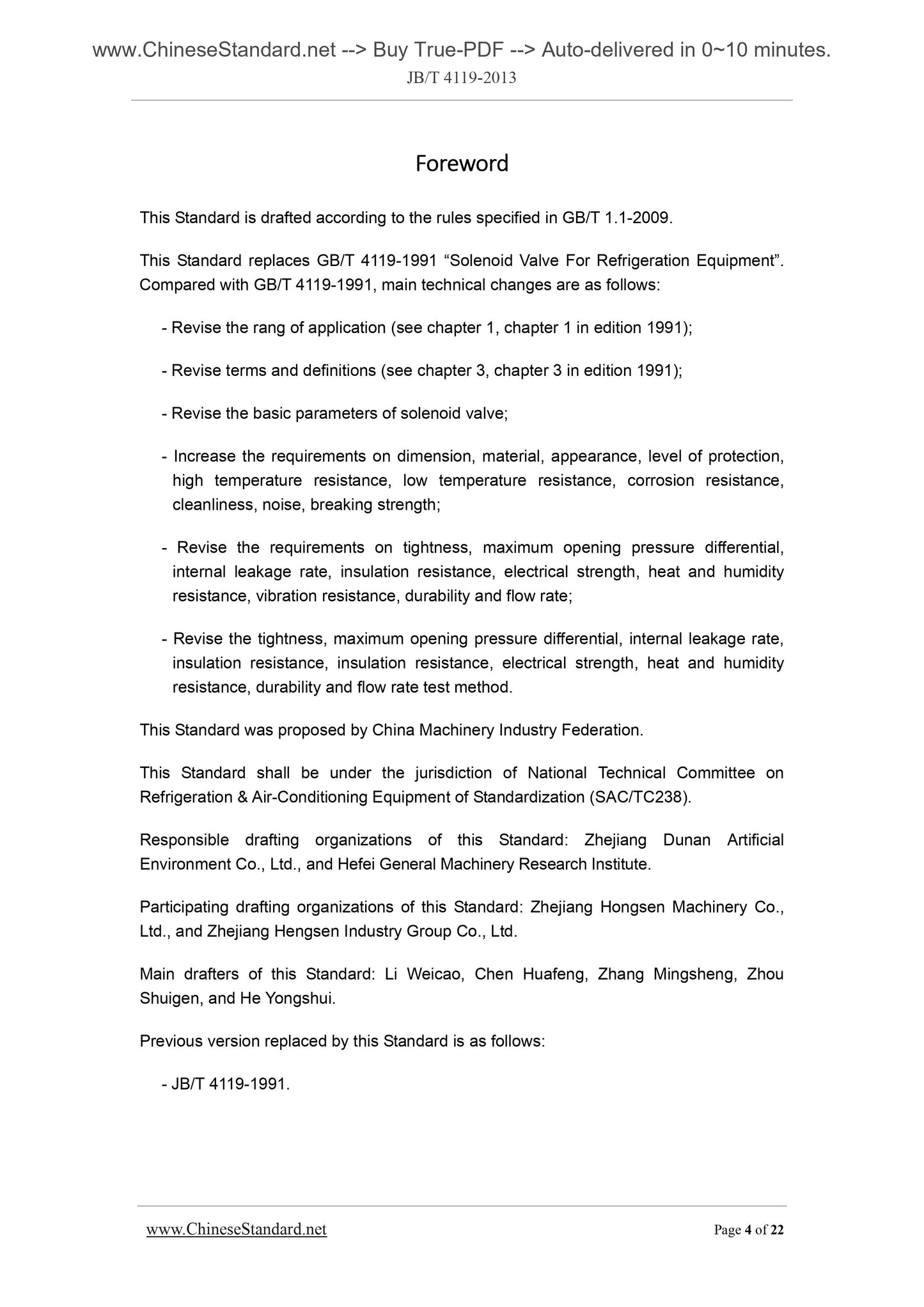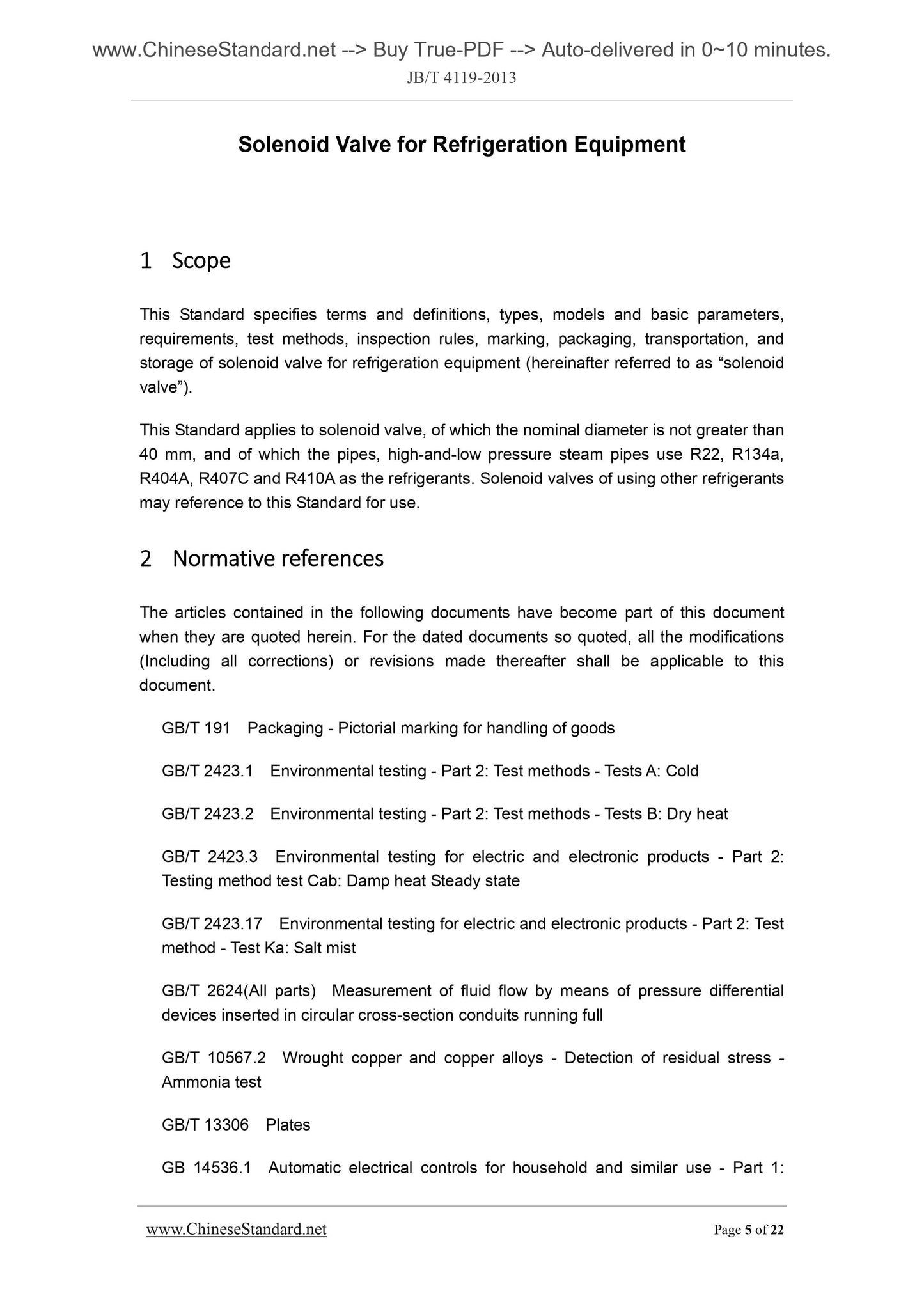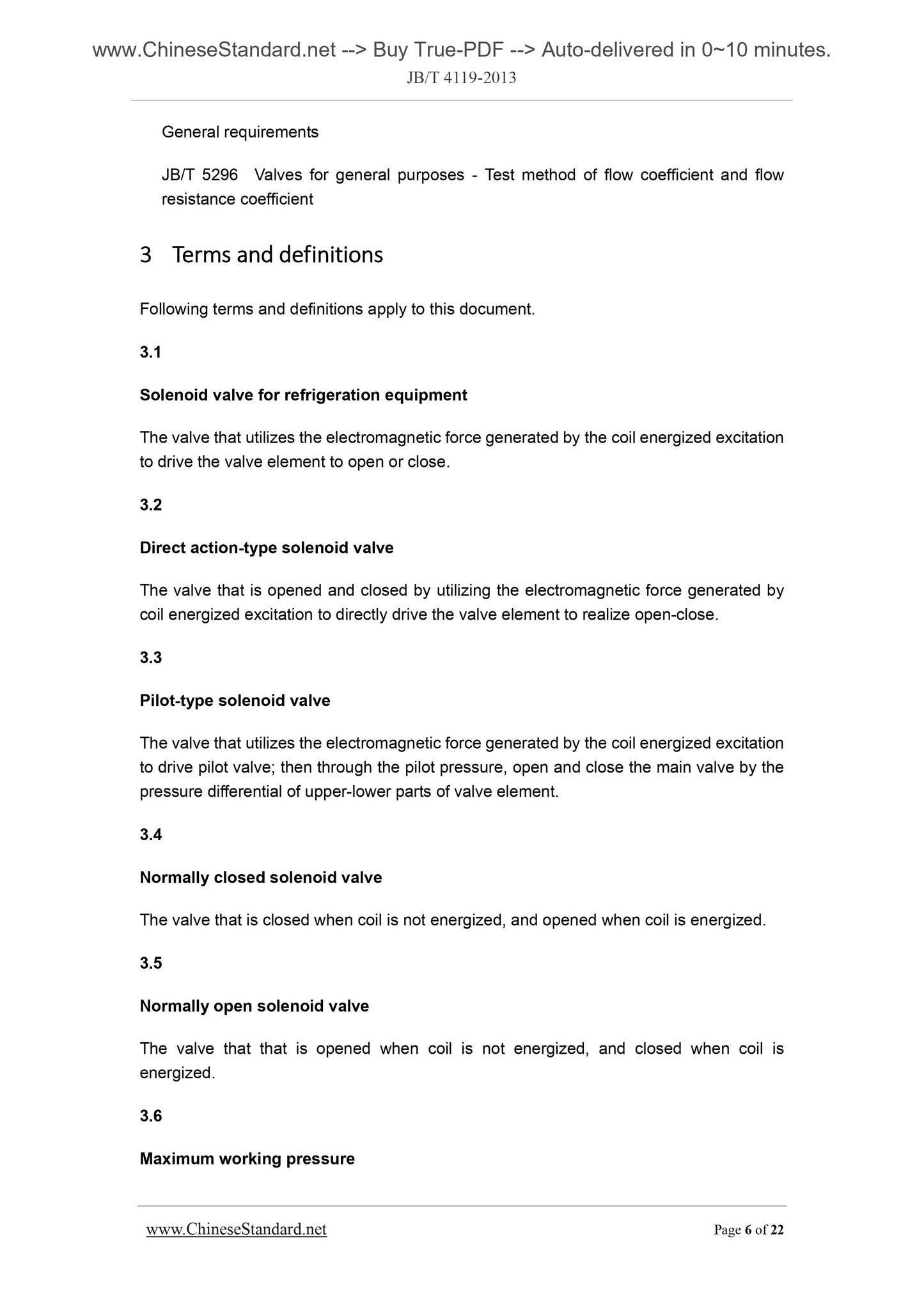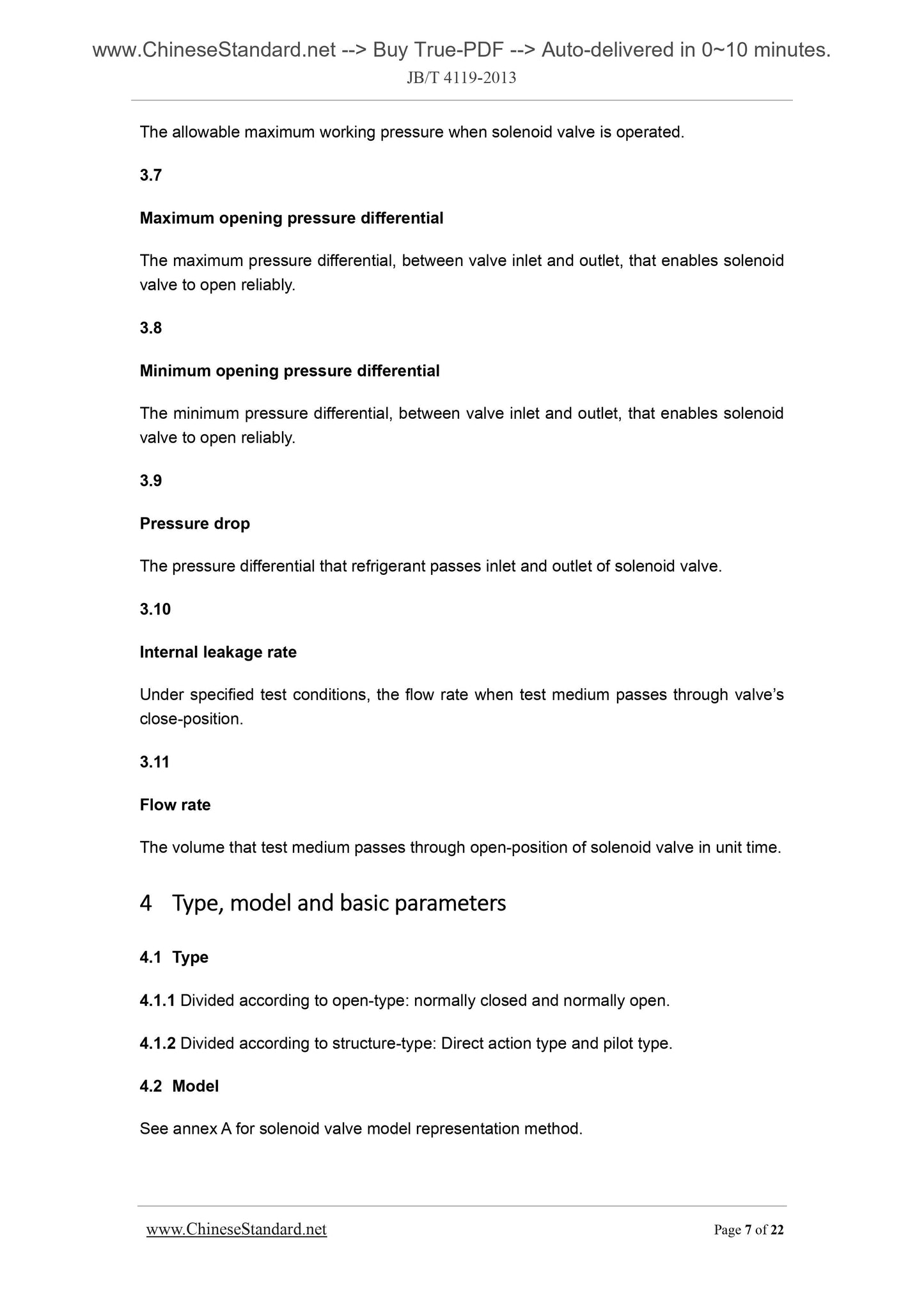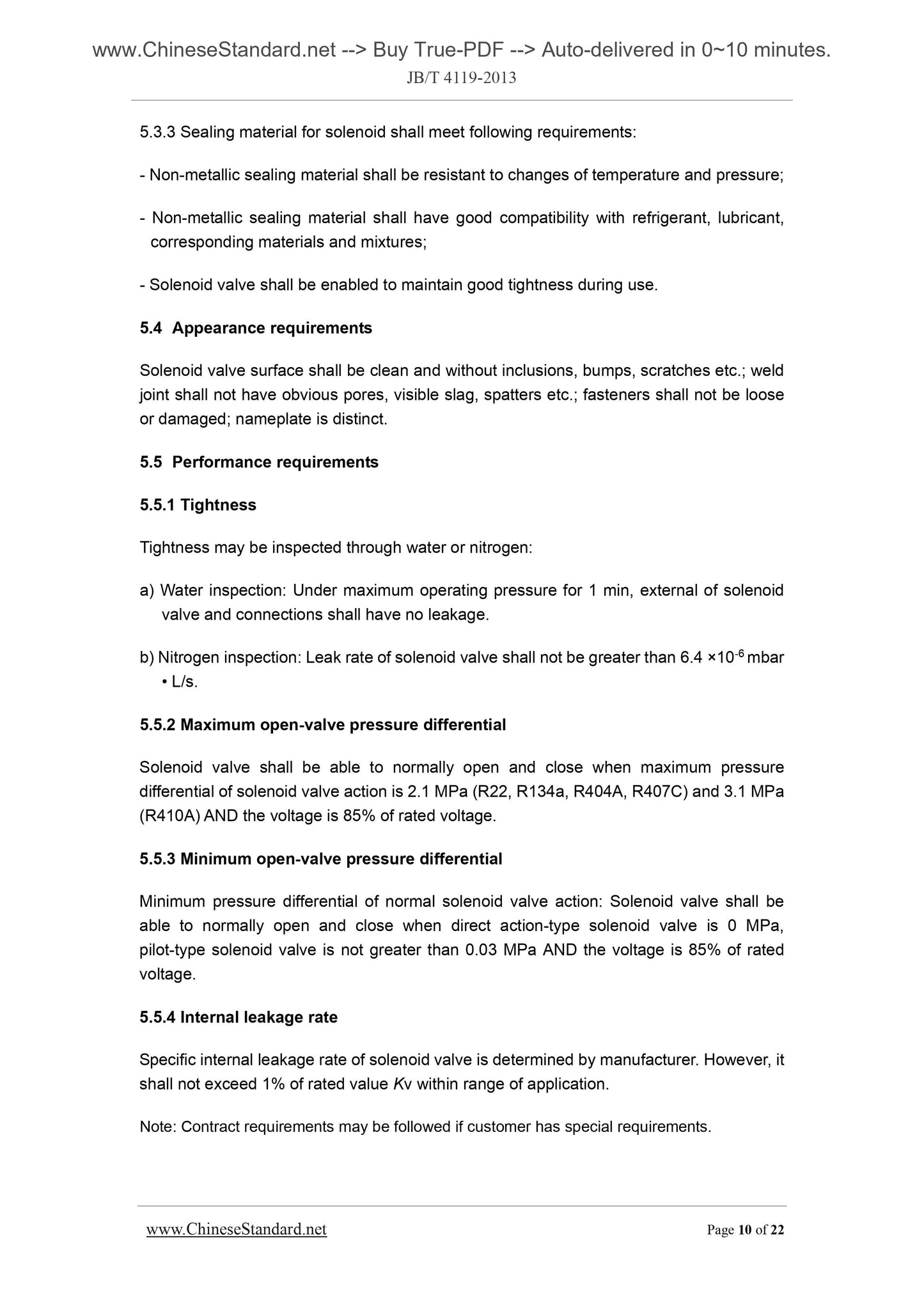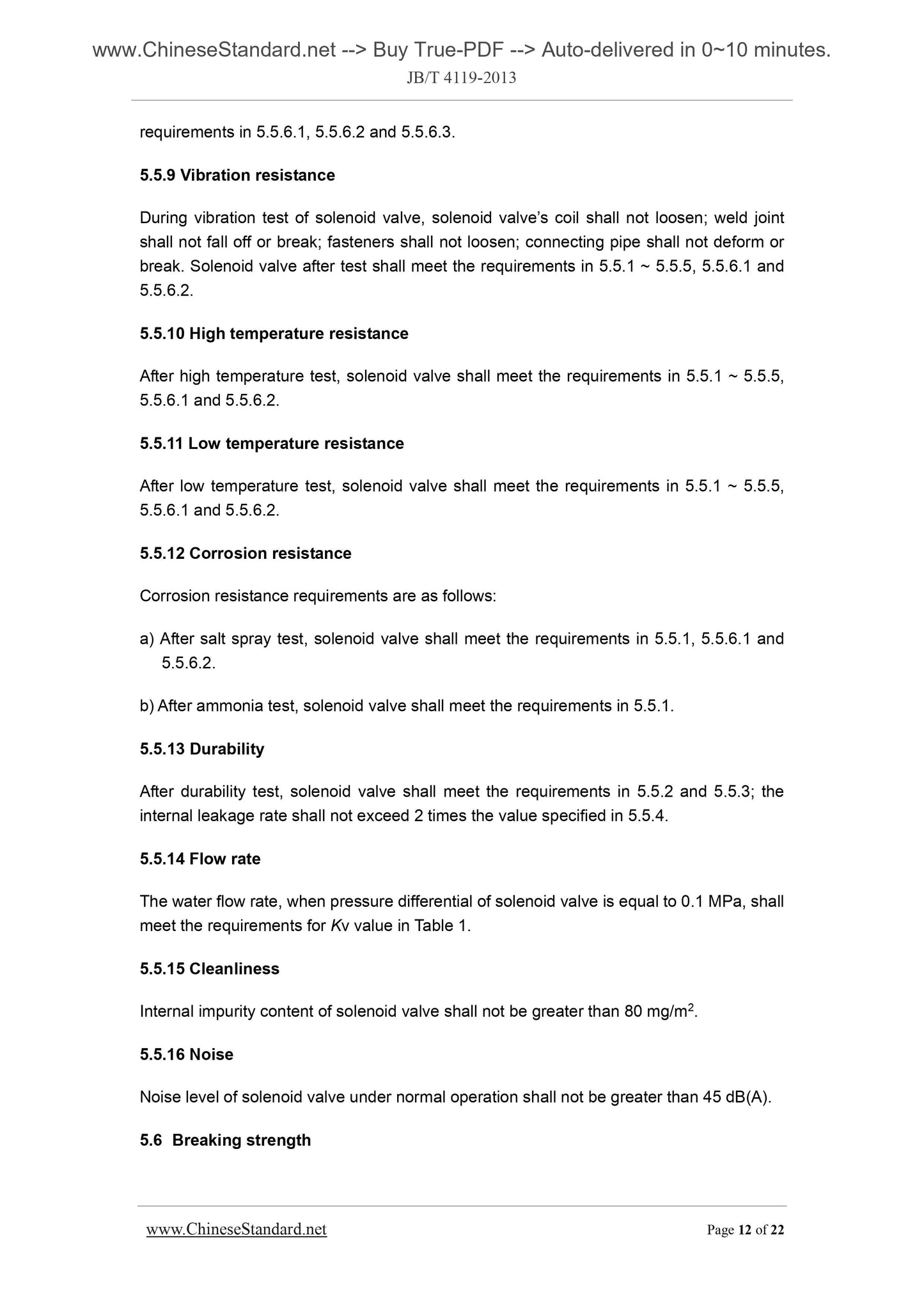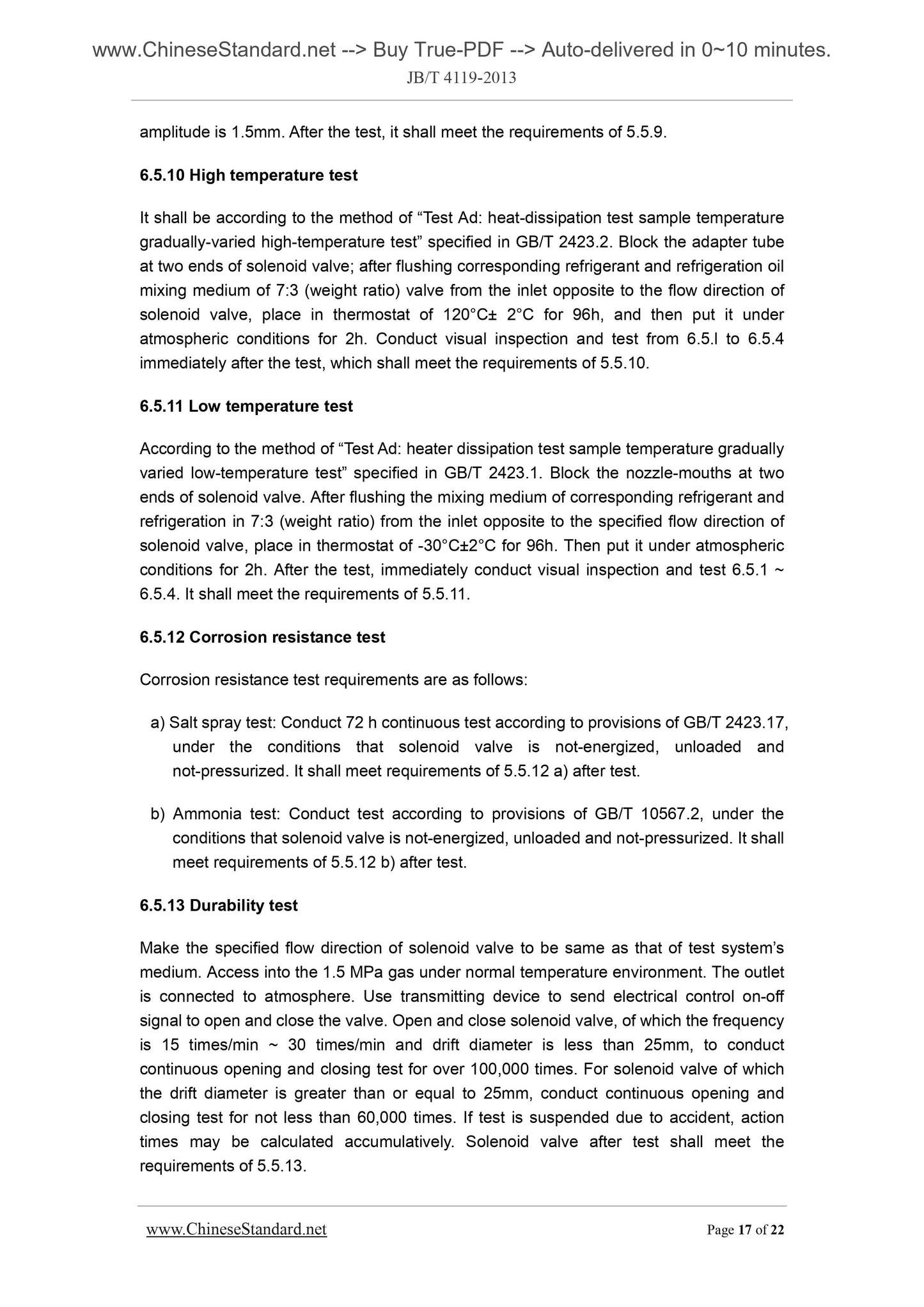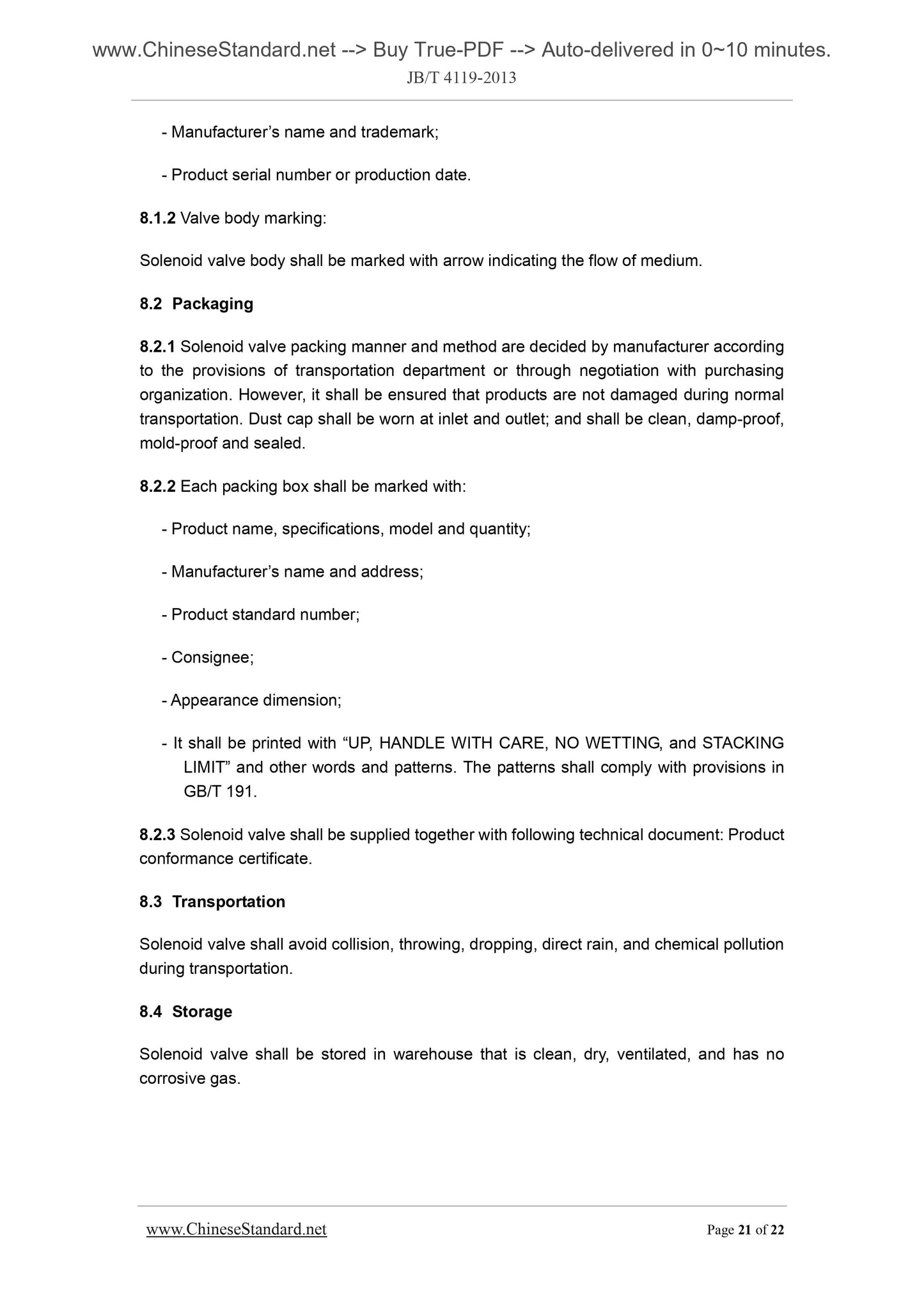1
/
of
10
PayPal, credit cards. Download editable-PDF and invoice in 1 second!
JB/T 4119-2013 English PDF (JBT4119-2013)
JB/T 4119-2013 English PDF (JBT4119-2013)
Regular price
$150.00 USD
Regular price
Sale price
$150.00 USD
Unit price
/
per
Shipping calculated at checkout.
Couldn't load pickup availability
Delivery: 3 seconds. Download true-PDF + Invoice.
Get QUOTATION in 1-minute: Click JB/T 4119-2013
Historical versions: JB/T 4119-2013
Preview True-PDF (Reload/Scroll if blank)
JB/T 4119-2013: Solenoid valve for refrigeration equipment
JB/T 4119-2013
JB
ICS 27.200
J 73
Record No.. 40597-2013
INDUSTRY STANDARD
OF THE PEOPLE’S REPUBLIC OF CHINA
Replacing JB/T 4119-1991
Solenoid valve for refrigeration equipment
ISSUED ON. APRIL 25, 2013
IMPLEMENTED ON. SEPTEMBER 1, 2013
Issued by. Ministry of Industry and Information Technology of the
People’s Republic of China
Table of Contents
Foreword ... 4
1 Scope ... 5
2 Normative references ... 5
3 Terms and definitions ... 6
4 Type, model and basic parameters ... 7
4.1 Type ... 7
4.2 Model ... 7
4.3 Basic parameters ... 8
4.4 Working conditions ... 8
5 Requirements ... 9
5.1 General requirements ... 9
5.2 Dimension requirements ... 9
5.3 Material requirements ... 9
5.4 Appearance requirements ... 10
5.5 Performance requirements ... 10
5.6 Breaking strength ... 12
6 Test method ... 13
6.1 Test requirements ... 13
6.2 Dimensional inspection ... 14
6.3 Material inspection ... 14
6.4 Visual inspection ... 14
6.5 Performance requirement test ... 14
6.6 Breaking strength test ... 18
7 Inspection rules ... 18
7.1 General requirements ... 18
7.2 Inspection classification ... 19
7.3 Ex-factory inspection ... 19
7.4 Sampling inspection ... 20
7.5 Type inspection ... 20
8 Marking, packaging, transportation and storage ... 20
8.1 Marking ... 20
8.2 Packaging ... 21
8.3 Transportation ... 21
8.4 Storage ... 21
Foreword
This Standard is drafted according to the rules specified in GB/T 1.1-2009.
This Standard replaces GB/T 4119-1991 “Solenoid Valve For Refrigeration Equipment”.
Compared with GB/T 4119-1991, main technical changes are as follows.
- Revise the rang of application (see chapter 1, chapter 1 in edition 1991);
- Revise terms and definitions (see chapter 3, chapter 3 in edition 1991);
- Revise the basic parameters of solenoid valve;
- Increase the requirements on dimension, material, appearance, level of protection,
high temperature resistance, low temperature resistance, corrosion resistance,
cleanliness, noise, breaking strength;
- Revise the requirements on tightness, maximum opening pressure differential,
internal leakage rate, insulation resistance, electrical strength, heat and humidity
resistance, vibration resistance, durability and flow rate;
- Revise the tightness, maximum opening pressure differential, internal leakage rate,
insulation resistance, insulation resistance, electrical strength, heat and humidity
resistance, durability and flow rate test method.
This Standard was proposed by China Machinery Industry Federation.
This Standard shall be under the jurisdiction of National Technical Committee on
Refrigeration and Air-Conditioning Equipment of Standardization (SAC/TC238).
Responsible drafting organizations of this Standard. Zhejiang Dunan Artificial
Environment Co., Ltd., and Hefei General Machinery Research Institute.
Participating drafting organizations of this Standard. Zhejiang Hongsen Machinery Co.,
Ltd., and Zhejiang Hengsen Industry Group Co., Ltd.
Main drafters of this Standard. Li Weicao, Chen Huafeng, Zhang Mingsheng, Zhou
Shuigen, and He Yongshui.
Previous version replaced by this Standard is as follows.
- JB/T 4119-1991.
Solenoid Valve for Refrigeration Equipment
1 Scope
This Standard specifies terms and definitions, types, models and basic parameters,
requirements, test methods, inspection rules, marking, packaging, transportation, and
storage of solenoid valve for refrigeration equipment (hereinafter referred to as “solenoid
valve”).
This Standard applies to solenoid valve, of which the nominal diameter is not greater than
40 mm, and of which the pipes, high-and-low pressure steam pipes use R22, R134a,
R404A, R407C and R410A as the refrigerants. Solenoid valves of using other refrigerants
may reference to this Standard for use.
2 Normative references
The articles contained in the following documents have become part of this document
when they are quoted herein. For the dated documents so quoted, all the modifications
(Including all corrections) or revisions made thereafter shall be applicable to this
document.
GB/T 191 Packaging - Pictorial marking for handling of goods
GB/T 2423.1 Environmental testing - Part 2. Test methods - Tests A. Cold
GB/T 2423.2 Environmental testing - Part 2. Test methods - Tests B. Dry heat
GB/T 2423.3 Environmental testing for electric and electronic products - Part 2.
Testing method test Cab. Damp heat Steady state
GB/T 2423.17 Environmental testing for electric and electronic products - Part 2. Test
method - Test Ka. Salt mist
GB/T 2624(All parts) Measurement of fluid flow by means of pressure differential
devices inserted in circular cross-section conduits running full
GB/T 10567.2 Wrought copper and copper alloys - Detection of residual stress -
Ammonia test
GB/T 13306 Plates
GB 14536.1 Automatic electrical controls for household and similar use - Part 1.
General requirements
JB/T 5296 Valves for general purposes - Test method of flow coefficient and flow
resistance coefficient
3 Terms and definitions
Following terms and definitions apply to this document.
3.1
Solenoid valve for refrigeration equipment
The valve that utilizes the electromagnetic force generated by the coil energized excitation
to drive the valve element to open or close.
3.2
Direct action-type solenoid valve
The valve that is opened and closed by utilizing the electromagnetic force generated by
coil energized excitation to directly drive the valve element to realize open-close.
3.3
Pilot-type solenoid valve
The valve that utilizes the electromagnetic force generated by the coil energized excitation
to drive pilot valve; then through the pilot pressure, open and close the main valve by the
pressure differential of upper-lower parts of valve element.
3.4
Normally closed solenoid valve
The valve that is closed when coil is not energized, and opened when coil is energized.
3.5
Normally open solenoid valve
The valve that that is opened when coil is not energized, and closed when coil is
energized.
3.6
Maximum working pressure
The allowable maximum working pressure when solenoid valve is operated.
3.7
Maximum opening pressure differential
The maximum pressure differential, between valve inlet and outlet, that enables solenoid
valve to open reliably.
3.8
Minimum opening pressure differential
The minimum pressure differential, between valve inlet and outlet, that enables solenoid
valve to open reliably.
3.9
Pressure drop
The pressure differential that refrigerant passes inlet and outlet of solenoid valve.
3.10
Internal leakage rate
Under specified test conditions, the flow rate when test medium passes through valve’s
close-position.
3.11
...
Get QUOTATION in 1-minute: Click JB/T 4119-2013
Historical versions: JB/T 4119-2013
Preview True-PDF (Reload/Scroll if blank)
JB/T 4119-2013: Solenoid valve for refrigeration equipment
JB/T 4119-2013
JB
ICS 27.200
J 73
Record No.. 40597-2013
INDUSTRY STANDARD
OF THE PEOPLE’S REPUBLIC OF CHINA
Replacing JB/T 4119-1991
Solenoid valve for refrigeration equipment
ISSUED ON. APRIL 25, 2013
IMPLEMENTED ON. SEPTEMBER 1, 2013
Issued by. Ministry of Industry and Information Technology of the
People’s Republic of China
Table of Contents
Foreword ... 4
1 Scope ... 5
2 Normative references ... 5
3 Terms and definitions ... 6
4 Type, model and basic parameters ... 7
4.1 Type ... 7
4.2 Model ... 7
4.3 Basic parameters ... 8
4.4 Working conditions ... 8
5 Requirements ... 9
5.1 General requirements ... 9
5.2 Dimension requirements ... 9
5.3 Material requirements ... 9
5.4 Appearance requirements ... 10
5.5 Performance requirements ... 10
5.6 Breaking strength ... 12
6 Test method ... 13
6.1 Test requirements ... 13
6.2 Dimensional inspection ... 14
6.3 Material inspection ... 14
6.4 Visual inspection ... 14
6.5 Performance requirement test ... 14
6.6 Breaking strength test ... 18
7 Inspection rules ... 18
7.1 General requirements ... 18
7.2 Inspection classification ... 19
7.3 Ex-factory inspection ... 19
7.4 Sampling inspection ... 20
7.5 Type inspection ... 20
8 Marking, packaging, transportation and storage ... 20
8.1 Marking ... 20
8.2 Packaging ... 21
8.3 Transportation ... 21
8.4 Storage ... 21
Foreword
This Standard is drafted according to the rules specified in GB/T 1.1-2009.
This Standard replaces GB/T 4119-1991 “Solenoid Valve For Refrigeration Equipment”.
Compared with GB/T 4119-1991, main technical changes are as follows.
- Revise the rang of application (see chapter 1, chapter 1 in edition 1991);
- Revise terms and definitions (see chapter 3, chapter 3 in edition 1991);
- Revise the basic parameters of solenoid valve;
- Increase the requirements on dimension, material, appearance, level of protection,
high temperature resistance, low temperature resistance, corrosion resistance,
cleanliness, noise, breaking strength;
- Revise the requirements on tightness, maximum opening pressure differential,
internal leakage rate, insulation resistance, electrical strength, heat and humidity
resistance, vibration resistance, durability and flow rate;
- Revise the tightness, maximum opening pressure differential, internal leakage rate,
insulation resistance, insulation resistance, electrical strength, heat and humidity
resistance, durability and flow rate test method.
This Standard was proposed by China Machinery Industry Federation.
This Standard shall be under the jurisdiction of National Technical Committee on
Refrigeration and Air-Conditioning Equipment of Standardization (SAC/TC238).
Responsible drafting organizations of this Standard. Zhejiang Dunan Artificial
Environment Co., Ltd., and Hefei General Machinery Research Institute.
Participating drafting organizations of this Standard. Zhejiang Hongsen Machinery Co.,
Ltd., and Zhejiang Hengsen Industry Group Co., Ltd.
Main drafters of this Standard. Li Weicao, Chen Huafeng, Zhang Mingsheng, Zhou
Shuigen, and He Yongshui.
Previous version replaced by this Standard is as follows.
- JB/T 4119-1991.
Solenoid Valve for Refrigeration Equipment
1 Scope
This Standard specifies terms and definitions, types, models and basic parameters,
requirements, test methods, inspection rules, marking, packaging, transportation, and
storage of solenoid valve for refrigeration equipment (hereinafter referred to as “solenoid
valve”).
This Standard applies to solenoid valve, of which the nominal diameter is not greater than
40 mm, and of which the pipes, high-and-low pressure steam pipes use R22, R134a,
R404A, R407C and R410A as the refrigerants. Solenoid valves of using other refrigerants
may reference to this Standard for use.
2 Normative references
The articles contained in the following documents have become part of this document
when they are quoted herein. For the dated documents so quoted, all the modifications
(Including all corrections) or revisions made thereafter shall be applicable to this
document.
GB/T 191 Packaging - Pictorial marking for handling of goods
GB/T 2423.1 Environmental testing - Part 2. Test methods - Tests A. Cold
GB/T 2423.2 Environmental testing - Part 2. Test methods - Tests B. Dry heat
GB/T 2423.3 Environmental testing for electric and electronic products - Part 2.
Testing method test Cab. Damp heat Steady state
GB/T 2423.17 Environmental testing for electric and electronic products - Part 2. Test
method - Test Ka. Salt mist
GB/T 2624(All parts) Measurement of fluid flow by means of pressure differential
devices inserted in circular cross-section conduits running full
GB/T 10567.2 Wrought copper and copper alloys - Detection of residual stress -
Ammonia test
GB/T 13306 Plates
GB 14536.1 Automatic electrical controls for household and similar use - Part 1.
General requirements
JB/T 5296 Valves for general purposes - Test method of flow coefficient and flow
resistance coefficient
3 Terms and definitions
Following terms and definitions apply to this document.
3.1
Solenoid valve for refrigeration equipment
The valve that utilizes the electromagnetic force generated by the coil energized excitation
to drive the valve element to open or close.
3.2
Direct action-type solenoid valve
The valve that is opened and closed by utilizing the electromagnetic force generated by
coil energized excitation to directly drive the valve element to realize open-close.
3.3
Pilot-type solenoid valve
The valve that utilizes the electromagnetic force generated by the coil energized excitation
to drive pilot valve; then through the pilot pressure, open and close the main valve by the
pressure differential of upper-lower parts of valve element.
3.4
Normally closed solenoid valve
The valve that is closed when coil is not energized, and opened when coil is energized.
3.5
Normally open solenoid valve
The valve that that is opened when coil is not energized, and closed when coil is
energized.
3.6
Maximum working pressure
The allowable maximum working pressure when solenoid valve is operated.
3.7
Maximum opening pressure differential
The maximum pressure differential, between valve inlet and outlet, that enables solenoid
valve to open reliably.
3.8
Minimum opening pressure differential
The minimum pressure differential, between valve inlet and outlet, that enables solenoid
valve to open reliably.
3.9
Pressure drop
The pressure differential that refrigerant passes inlet and outlet of solenoid valve.
3.10
Internal leakage rate
Under specified test conditions, the flow rate when test medium passes through valve’s
close-position.
3.11
...
Share
